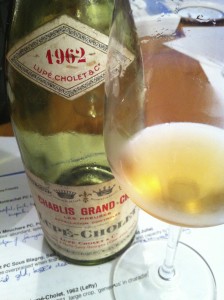Wine writers and drinkers have been exercised by what is referred to as premature oxidation in white Burgundy since the 1996 vintage. This is a slightly vague condition in which high quality wines from top village, Premier Cru and Grand Cru sites fail to live up to their promise, being either obviously oxidised or just failing to shine, lacking zip and energy. Saturday’s tasting was called ‘does white Burgundy age?’ but frankly after the tasting the answer was so obviously ‘yes’ that I have changed the title to ‘how’ it ages. Thus, of our eight wines, only one showed signs of premature oxidation and even then that did not spoil it completely. As we will see, even this wine still outperformed expectation.
The tasting was made up of a short vertical of four basic Bourgogne Blanc from Coche-Bizouard, a grower in Meursault, and then a selection of premier and grand crus. The vintages were pretty much all good years. What did we find?
Even simple Bourgogne Blanc from a good grower can age attractively for up to a decade. The Coche-Bizouard wines really shone and at £10-£11 a bottle showed that you can still get classy wines for a decent price. The 2011 showed pleasant oak over melon and peach fruit with excellent acidity, the key to ageability in these wines. The 2009 was at the perfect point of development for those who like a balance between fresh fruit and tertiary notes with a mineral seam beginning to show. The 2007 from a slightly less good vintage that its companions was into full-on butterscotch-and-baked apple-mode with a slightly sharp, even metallic finish. Even the 2005, at nine years old, was a mixture of obvious oxidation over a lovely mushroom and truffle nose and mellow fruit on the palate. Even if it was the only oxidised wine of the evening, it showed a remarkably class for a basic Burgundian white.
Class will out!
- as a neat pair with the last Coche-Bizouard, we had another wine from the same vintage: Puligny-Montrachet, PC Les Folatières, Moret-Nominé 2005, more than three times the price of the above but, unlike the basic 2005, fresh and still in its relative infancy. Beautiful, fresh nose, well integrated ripe fruit and honey notes with a hint of undergrowth, this had rich, textured almost mango fruit on the palate and a long, complex finish. This wine clearly had the potential to age for another decade or so.
- from the middle of ‘premox’ years, Puligny-Montrachet, PC Clos de Mouchere 1999 was in splendid form, with more than a hint of farmyard, entirely to be expected from a 15 year old, but with marked honey aromas, an excellent depth of palate, fine, rich and long. Of course the really annoying thing about so called premature oxidation has been its intermittent, irregular nature – some bottles affected, some not. Clive Coates also comments that some bottles recover from this phase rather like wines that go through a dumb phase. (Presumably he means that some bottles from a case that showed premox at one stage are not affected, though it would be difficult to claim more than that some bottles are affected and some not.)
- Pre-premox wines can be in great fettle: Meursault, PC Sous Blagny, Sélection, Nicholas Potel, 1992 was showing oxidation appropriate to its age, lovely mid gold colour, butterscotch and tarte tatin, nuttiness and a good concentration of orange and orange rind fruit.
The great survivor
 The debate about premox concerns whether white Burgundy can age and get more complex over 15-20 years. It is asking a lot for white wines to remain fresh and interesting in further decades beyond that though some with really high acidity or skin contact may. But what then about a Chablis that is more than half a century old? Chablis GC Les Preuses, Lupé-Cholet, 1962 triumphantly showed that white Burgundy can shine in its fifty-second year. There was a good level in the bottle, the cork came out nearly in one piece, and the bottle had probably had one careful owner though he can’t remember when he bought it! In the glass the wine was a light amber in colour with a nose that was reminiscent of walnuts, smoked bacon and a touch of cooked citrus. It was sublimely light and elegant on the palate. Overall it was an incredible survivor. While this wine was made half a century before we began to worry about premature oxidation, it – and the others in this small tasting – showed that white Burgundy can age beautifully. And that it follows the usual path from fresh fruit and oak-relationd aromas to ethereal, tertiary notes.
The debate about premox concerns whether white Burgundy can age and get more complex over 15-20 years. It is asking a lot for white wines to remain fresh and interesting in further decades beyond that though some with really high acidity or skin contact may. But what then about a Chablis that is more than half a century old? Chablis GC Les Preuses, Lupé-Cholet, 1962 triumphantly showed that white Burgundy can shine in its fifty-second year. There was a good level in the bottle, the cork came out nearly in one piece, and the bottle had probably had one careful owner though he can’t remember when he bought it! In the glass the wine was a light amber in colour with a nose that was reminiscent of walnuts, smoked bacon and a touch of cooked citrus. It was sublimely light and elegant on the palate. Overall it was an incredible survivor. While this wine was made half a century before we began to worry about premature oxidation, it – and the others in this small tasting – showed that white Burgundy can age beautifully. And that it follows the usual path from fresh fruit and oak-relationd aromas to ethereal, tertiary notes.


Comments are closed.